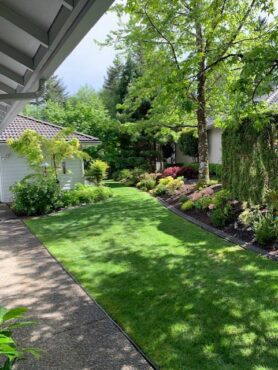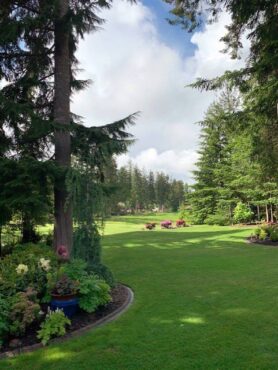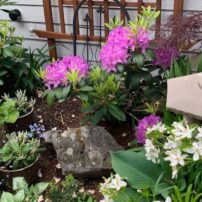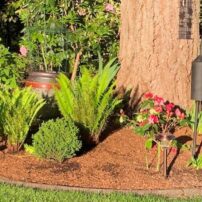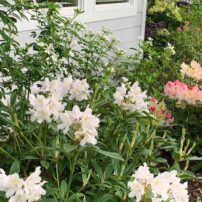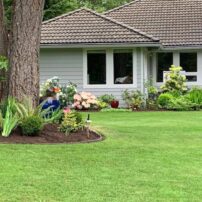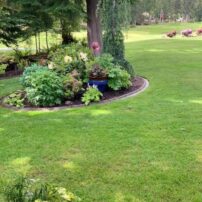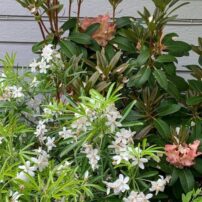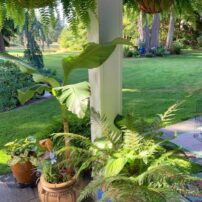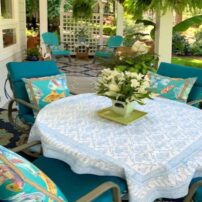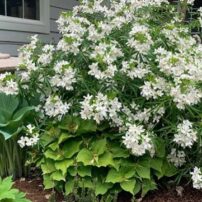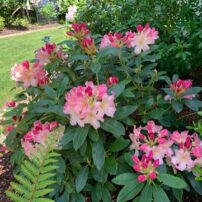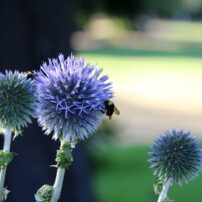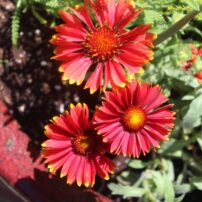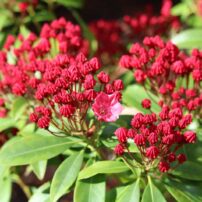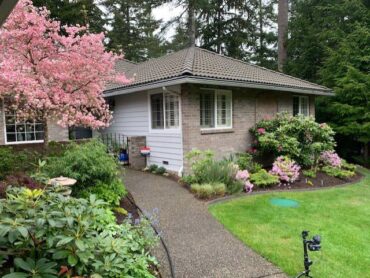
The advantage of living on a golf course is in the “borrowed” backdrop for a garden’s landscape, along with beautiful, established trees to frame the vista. Toby and Tom Mason moved to McCormick Woods six years ago. Their location on the 4th hole offers a lovely long view across the green to a pond.
Both avid gardeners, the couple had previously lived in Port Orchard, where they had an extensive and more formal garden. They wanted a smaller house and a more casual garden.
The new yard mostly had overgrown rhododendrons and a jungle of blackberry, huckleberry and salal, so high, they blocked the view of the golf course. The first step was to remove all of the blackberry vines. Most of the old rhodys were replaced with fresh new varieties. Some of the best huckleberry bushes and salal were left and brought under control.
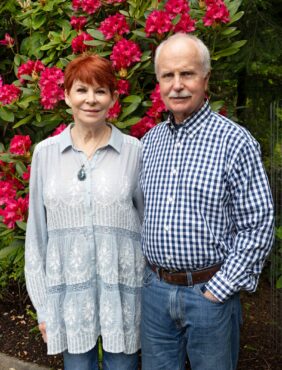
Toby Mason has a degree in horticulture and many years of experience as a florist. She wanted to keep a lot of the native greenery because the leaves of both huckleberry and salal are excellent to use in floral arrangements. The garden, after years of work, is now not only a delight to look at but an excellent source for the flowers and greenery she uses in her arrangements.
After getting the old growth cleaned up and under control, Tom Mason began reshaping the beds around the house, the perimeter of the garden and the bases of some of the magnificent old trees on the property, making it easier for him to mow the lawn. Beds are edged with curbing to keep them neat; the lush, green lawn now leads the eye toward a view of the golf course beyond.
Creating the Garden
The first plants that went into the new beds were brought from the old house (ones that Toby couldn’t bear to leave behind): trilliums, peonies, roses, columbine and over 30 hostas. Large pots that came along to the new house were placed all together on the covered patio until a decision could be made about where they would go. The morning after the move, the Masons were met with the remains of an obvious deer banquet during the night: All of the container plants had been eaten down to the soil.
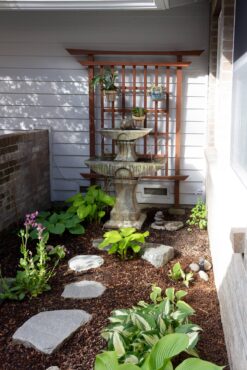 Now the deer problem seems under control. The Masons swear by the success of the motion-controlled sprinklers that manage to keep the four-footed feasters out of the garden.
Now the deer problem seems under control. The Masons swear by the success of the motion-controlled sprinklers that manage to keep the four-footed feasters out of the garden.
Once the basic bones of the garden were in place, Toby began selecting new plants that filled her requirements for flower arranging.
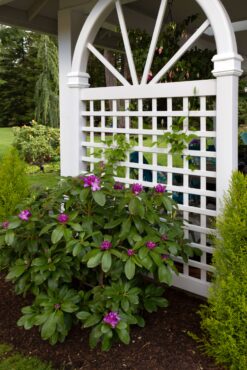 “I planted for my own favorite color scheme and for the site: by shade, sun and size,” she says. “I also kept disease resistance and bloom time in mind.”
“I planted for my own favorite color scheme and for the site: by shade, sun and size,” she says. “I also kept disease resistance and bloom time in mind.”
She likes to plant sections in small vignettes that echo how the plants will look in the vase, so going through the garden in spring and summer is akin to visiting a well-designed flower show. She chooses plants with a florist’s eye and makes sure she always has plenty of flowers and greenery available for her arrangements through the seasons.
Beds are planted with lots of summer perennials such as astilbes, peonies, roses, columbine, crocosmia and globe thistle. Hostas and ferns fill in the shady spots. Colorful annuals are added every spring in the sunny areas. Flowering shrubs, vines and trees such as choisya, dogwood, kalmia, magnolia, rhododendrons and azaleas provide color through various seasons.
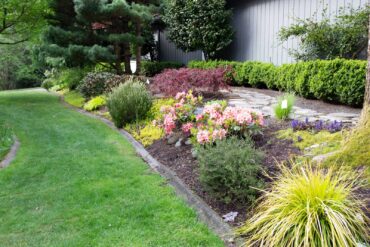 A handsome white trellis gives a feeling of privacy and enclosure on the edge of the patio that faces the neighboring backyard. In summer, it’s covered with purple clematis.
A handsome white trellis gives a feeling of privacy and enclosure on the edge of the patio that faces the neighboring backyard. In summer, it’s covered with purple clematis.
The patio comes alive in late spring with containers of tropical plants such as brugmansia, banana, canna and ‘Bird of Paradise,’ turning the patio into a tropical paradise and a perfect place for outdoor meals and entertaining. The wonderful thing about tropical plants is the fact that deer don’t eat them: They aren’t on a deer’s Northwest menu. The downside is that they are tender and need to be overwintered indoors and brought back out in spring after all chance of frost has passed.
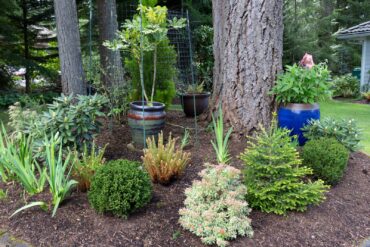 The front entryway is another deer-proof area. A low wall and decorative gate enclose a small, shady courtyard. A Japanese-inspired trellis and water feature are the focal point for shade-loving hostas and a small Buddha statue. In the warm months, the Masons enjoy the sound of the fountain through the dining room window.
The front entryway is another deer-proof area. A low wall and decorative gate enclose a small, shady courtyard. A Japanese-inspired trellis and water feature are the focal point for shade-loving hostas and a small Buddha statue. In the warm months, the Masons enjoy the sound of the fountain through the dining room window.
The Masons work at having a “garden for all seasons,” being sure to plan for plants that will fill in and cover up for flowing perennials as they go out of bloom. They believe in going with nature’s cycles, having patience and appreciating the whole cycle, not just the time span when the plants are at their showiest.
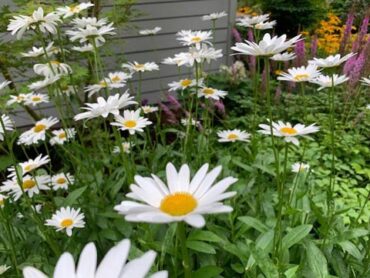
Special attention is paid to leaf shape, texture and shades of green. And ferns, ferns, ferns! There’s quite a collection of gorgeous ferns and, with Toby’s horticultural expertise, she has offered a list of her favorite ones with both the scientific name and the variety (see next page). It’s important to check the species designation (the second part of the scientific name) because there are so many different species within each genus. There are also lists of cutting flowers and greens for floral bouquets.
Golf Course Living
Living on a golf course is somewhat like living in a goldfish bowl, but it’s nice to have golfers pause to look at and praise the garden. Neighbors on one side are also avid gardeners but are separated by natural plantings of huckleberry, salal and trees. The neighbors on the other side are in close proximity, but a long bed, replanted with hardy perennials, helps to visually separate the properties. A tall, solid privacy fence painted white ties in with the white trellis on the patio and masks the unattractive backsides of the row of aged arborvitae in the neighboring yard.
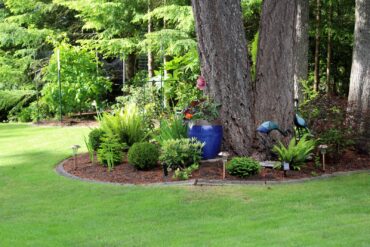 Containers placed throughout the garden are designed in much the same way as floral bouquets, with an eye for balance in size, leaf shape and complimentary flower color. Doorways, gates and fences are adorned with Toby’s artistic baskets and wreaths year round.
Containers placed throughout the garden are designed in much the same way as floral bouquets, with an eye for balance in size, leaf shape and complimentary flower color. Doorways, gates and fences are adorned with Toby’s artistic baskets and wreaths year round.
In summer, they’re often filled with fresh flowers and greenery, but in other seasons she loves to create magnificent arrangements with silk flowers, leaves and ferns. Her bouquets of silk flowers for indoors are much in demand and can be found in almost every room of the Masons’ house.
It’s like living in a florist’s shop: truly a garden of delights both indoors and out.




